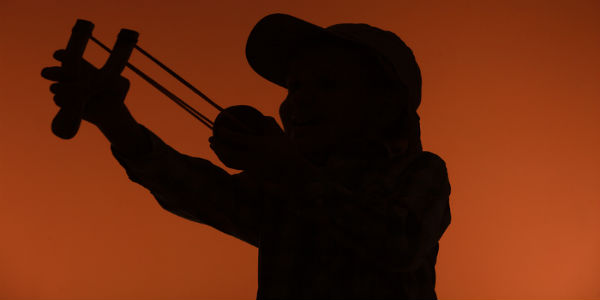How David can beat Goliath in capturing Millennials

Everybody loves a David and Goliath story, especially when we are in a small but virtuous “David” industry facing Goliaths. It may be part of who we are as a nation, having won our independence against all odds as a small group of virtuous colonies fighting against an empire. Even in sports, we celebrate when a clever underdog finds a way to beat an imposing opponent. It was hard not to root for the feisty Butler Bulldogs in 2010 and 2011 as they faced much larger opponents in the NCAA tournament.
In each case, the smaller competitor abandoned traditional tools and tactics in favor of those which would highlight their strengths while mitigating the strengths of their opponents, or even using those strengths against them. More importantly, the tactics used could not be matched by their opponents.
- For David, it was the sling. Had he brought a heavy sword to fight Goliath, the Bible would be a bit shorter. Goliath’s big body made him strong, but his big head made for an easy target. His strength was now his weakness. Had Goliath brought a sling, he’d have had difficulty hitting a small and agile opponent. Goliath could not match David’s tactics – even if he wanted to.
- For the revolutionaries, guerilla warfare gave advantage to small groups with lifelong knowledge of the land. At a time when shooting back and forth in an open field was conventional, and the larger army with better rifles was sure to win a battle of attrition, guerilla warfare used the Red Coats’ strengths of organization, rigid structure and size against them. The patriots’ knowledge of the land could not be replicated by these foreigners.
- The Butler Bulldogs use a unique recruiting tactic which deemphasizes stats in favor of intangible qualities. Legacy powerhouse schools would never give up a blue chip athlete to award scholarships to “no-stats all-stars,” as MoneyBall author Michael Lewis calls them, if only for fear of boosters rioting. They could never match this tactic.
In banking, the conventional tool for acquiring new business is paid advertising. The tools and tactics credit unions can use to level the playing field are already available, but many in our industry insist that we can win with conventional advertising tactics. We can’t.
Consider our weakness, which is clearly size. Each of the “big four” banks in the United States holds more assets, individually, than all U.S. credit union assets combined. It stands to reason that their advertising spends, individually, dwarf the aggregate credit union spend as well. What credit unions lack in budget, they make up in the oft-recited virtues of better rates, fewer fees, and better service. Additionally, we’re an industry built upon transparency and corporate responsibility, which are important factors in millennials’ buying decisions. That’s great, except few of them have any idea that we exist. Considering the fact that only 1/3 of millennials trust TV ads, and most of them don’t own TVs anyway, our little credit union ad touting better rates and fewer fees is virtually worthless, especially considering it is probably sandwiched between two bank ads with celebrities saying the same thing.
As a strategist seeking a way to capitalize upon our strengths, you’d look for a tool which places our rates, fees and service in apples to apples competition with big banks, and rewards transparency and corporate responsibility. You’d also hope to diminish the strength of banks by establishing a tool which does not rely on an advertising budget, and penalizes businesses with traditions of misinformation and customer abuse. In fact, you’d hope that a big bank’s strength in having a larger advertising budget would become a weakness, perhaps by leading interested parties to a head to head comparison. Lastly, you’d look for a tool or tactic which cannot be immediately replicated by banks. In social media, you have all of these.
- Social media highlights our own strengths: Consumer reviews on Facebook, Yelp etc. are not written by marketers. There is no puffery, clever wording, or asterisk chasing. No expensive compliance or PR department is approving anything, and the result is raw, unbiased, transparent and free. The smallest credit union and the largest bank appear right next to each other, with only their average review to separate them. Furthermore, consumer reviews are far more influential than polished TV ads, in both trustworthiness and usage. Millennials are about 30% more likely to trust consumer reviews than TV or radio ads, and according to a 2014 Mintel study quoted in the Chicago Tribune, “nearly 70 percent of consumers, and 82 percent of millennials, seek opinions before buying.”
- Social media mitigates our competitors’ strengths or makes them counterproductive: If consumers aren’t relying upon advertisements to make their buying decisions, then the biggest advertising budget in the world is ineffective. Worse yet for big spenders is that traditional ads are generally the first step in a sales attribution chain which increasingly leads to reviews on social media. How unfortunate to spend millions of dollars to send consumers to your long list of poor reviews and a head to head competition with a more favorable competitor!
- Social media goodwill cannot be easily matched by our competitors: In the decades leading to this one, advertisers controlled the conversation about their brands with advertising. In this era, an investment in customer service was not as appealing as money in media. Meanwhile, smaller competitors made member service investments, relying as they always have on positive word of mouth as their primary tactic in gaining new business. The amplification of word of mouth advertising through the bullhorn of social media could not have been predicted by big banks or smaller organizations, but it benefits the latter immediately while causing the former to change course.
Now, all we need is evidence of success, right? As a “David” I hope not. David had no evidence that his strategy would work, but only evidence that traditional methods would not. Using a weapon customized to his strengths was his only shot at being the victor. Butler had little evidence that recruiting “no-stat all-stars” would result in success, but there was empirical evidence to show that they could not compete with traditional recruiting. Changing their recruiting strategy was the only option that resulted in a chance to win. Likewise, there is little evidence to support the idea that there is ROI in social media, but there is strong evidence to support the idea that credit unions cannot compete with big banks by using traditional media. A dollar spent here is the equivalent of a rifle volley in an open field, and credit unions cannot compete in a battle of attrition using traditional media. Conversely, a dollar spent on social media is an investment in a customized tool which gives us a clear advantage and a chance to win.
If “advertising is what you pay for and PR is what you pray for” then credit union marketers got exactly what we’ve been praying for. Now, if we could just convince industry CEOs it’s what they’ve been praying for, too.

